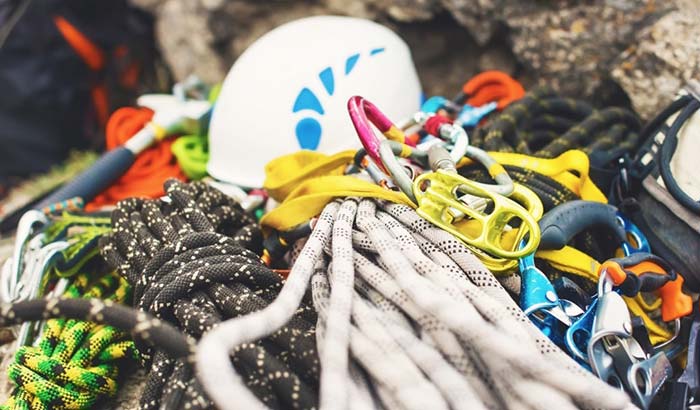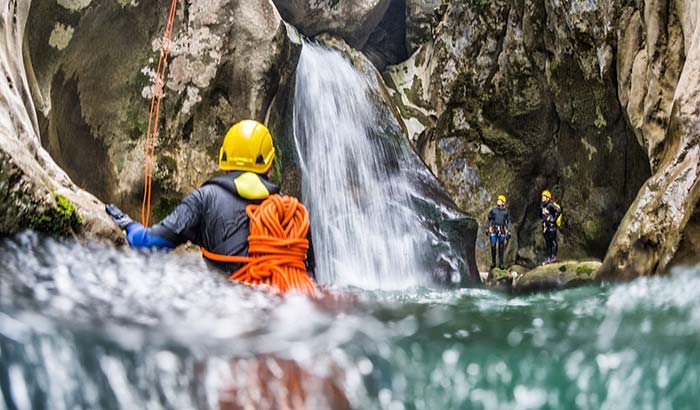It is essential to have the right equipment if you are just new to any climbing activity. Whether outdoor or indoor, choosing the right climbing rope is necessary to ensure safety and dependability in any climbing exercise. There are several factors and options to consider in choosing the right climbing rope, just like choosing between the dry rope vs non dry rope. But what are the difference between the two?
The climbing roof can be classified according to its water-repelling properties: dry rope and non dry rope. Both of these classifications are actually used in the climbing community depending on the type of climbing activity you are doing. In this article, we will be detailing the comparison between the two types of ropes and how it affects to the climber and the climbing activity. We also provide other related information so that you can have the right decision in choosing between these two types of climbing roofs.
Contents
Dry Rope: Excellent Water-Repelling Properties
Dry climbing ropes are manufactured with excellent water-repelling properties. Meaning they are built with chemicals and made in such a way that they are resistant to absorbing water. The rope’s sheath comes with a dry treatment which means it is built with individual fibers that are treated to repel water. So, once the sheath is located on the outside, it has the capacity to protect the rope against water invasion.
With all the features mentioned, dry ropes are an excellent tool when it comes to wet environments. If you are doing ice climbing, mountaineering, alpine climbing, and other similar activities, the dry rope is the right climbing rope to have. The dry coating on the roof’s surface will prevent the water from penetrating to keep it comfortable to use even in wet conditions.
Another upside to having a dry rope is its durability and toughness. Since it’s built to have resistance to water entry, it is understandable that this is more tough and durable compared to the non-dry rope. The durability can also save a lot of money since it naturally lasts longer, which means it will take time before you even retire it.
Non Dry Rope: Non-Water-Repelling Climbing Rope
The non-dry climbing rope is manufactured with no treatment to repel water. Meaning, they can absorb the most water and will be heavier once it is soaked with it. When a non-dry rope is wet, it also loses its dynamic strength, which will make the fall a lot harder. However, the issues mentioned are just temporary as this type of rope will be back with its usual features once it dried up.
But when it comes to doing different climbing activities, I can say that you use non-dry climbing rope as long as the activities you are doing are not exposed to water. So, if you are a normal individual that enjoys indoor or outdoor sports climbing, then the non-dry rope is precisely what the doctors ordered.
Dry Rope Vs. Non Dry Rope: What is the difference?
Since you already know the traits and the properties of both dry and non-dry climbing ropes, comparing the two will give you some idea of what to use in a climbing activity. It will also give you some insights that will help you choose the right one for your preferred climbing activity.
Water-Repelling Properties
The main difference between the two climbing ropes is their ability to repel water. The Dry climbing rope is manufactured to repel water entry on the surface and is equipped with a water repellent coating. Obviously, non-dry climbing ropes do not come with a water repellent coating and do not prevent water from coming inside the rope.
The dry rope is best suited to be used in wet climbing conditions such as ice climbing, alpine climbing, and mountaineering. Meanwhile, when a non dry climbing rope gets wet, the fiber inside it will readily absorb the water and expand, which can loosen the effectiveness of the rope. However, it can be temporary because once it dried again, its features would also come back.
Price Point
Another obvious difference between the two is the cost. The non-dry climbing rope is more affordable because of how it is manufactured. Since the dry climbing rope is built with water-repelling properties, it is understandable that it also comes with a higher price point when compared to the two.
However, please take note that the price difference will also vary depending on other factors such as the brand and other variables. A good example is the double-coated dry rope which should be more expensive than a similar dry rope with a single coating. The price difference can also vary depending on the length of the rope you are buying.
Durability
As I mentioned earlier, dry climbing rope is more durable compared to non-dry one. Naturally, dry climbing rope is built to be tough and durable in wet conditions. However, the water-repelling coat found on the surface makes it durable and equally rugged in other situations.
Usage
The dry and non-dry ropes are built to be used on different climbing activities, but both completely have different usage. For one, the non-dry climbing rope is perfect for regular climbers, especially those who are doing indoor climbing and doing some short dry routes. Meanwhile, a dry rope is built to be used in climbing activities where the environment is expected to encounter excessive moisture.
Conclusion
When you are just starting to learn climbing, it is normal for you to learn and compare the two classifications of climbing rope: dry rope vs non dry rope. The most important thing is to understand the properties, features, and differences between the two because it will serve as your guide for buying the rope that will fit your climbing activities.
More importantly, when buying a climbing rope, you will need a lot of consideration and thinking, especially to the features of its rope and how it fits you as a mountain climber. However, do not get me wrong, the two climbing ropes are all come with important usage in the world of sports climbing. So, when it comes to choosing what rope you want, it all boils down to the type and the location of your climbing activities.


